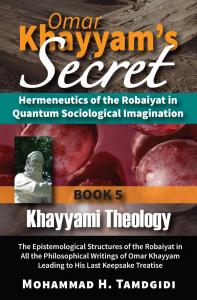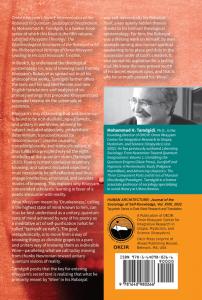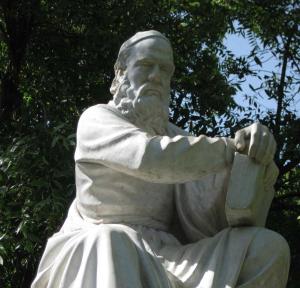"Khayyami Theology": Book 5 of the 12-Book Series "Omar Khayyam's Secret" Published
New Book offers the Arabic texts and updated Persian & new English translations & analyses of all of Khayyam's philosophical writings before his last treatise.
In the book, aiming to understand the theological epistemology (or, way of knowing God) framing Khayyam’s Robaiyat as spread out in all his philosophical works, sociologist and Khayyami scholar Mohammad H. Tamdgidi, Ph.D., offers the Arabic texts, his update Persian and new English translations, and analyses of all of Khayyam's philosophical writings before his last keepsake treatise.
The six primary texts include: 1: Khayyam’s annotated Persian translation of Avicenna’s sermon in Arabic on God and creation; 2: Khayyam’s treatise in Arabic addressed to Nasawi (who the new study shows has been wrongly regarded as an Avicenna pupil) on the created world and worship duty; 3-5: Khayyam’s three treatises in Arabic (which the new study shows were all addressed to Abu Taher, to whom Khayyam also dedicated his treatise on algebra) that are separate chapters of a three-part treatise on existence on topics ranging from the necessity of contradiction, determinism, survival, attributes of existents, and the light of intellect on ‘existent’ as the subject matter of universal science; and 6: Khayyam’s treatise in Arabic addressed to Moshkavi (who the new study reveals was a supportive Shia intellectual) in response to three questions on soul’s survival, on the necessity of accidents, and on the nature of time.
In the book it is shown that the most fruitful way of understanding Khayyam’s six texts is by regarding them as efforts made at defending his “succession order” of creation thesis implicitly revealed when commenting on Avicenna’s sermon and finalized in his last keepsake treatise. The texts served to offer the theological epistemology behind Khayyam’s thesis, revealing his creative conceptualist view of existence that informed his poetic way of going about knowing God, creation, and himself within a unitary Islamic creationist-evolutionary worldview.
Khayyam’s way of knowing God and existence is found to be non-dualistic, non-atomistic, and unitary in worldview, allowing for subject-included objectivity, probabilistic determinism, transcontinuous (or ‘discontinuous’) creative causality, transdisciplinarity, and transculturalism; it thus fulfils in a prescient way all the eight attributes of the quantum vision (Tamdgidi 2020). Poetry is most conducive to unitary knowing, and subject-included objectivity must necessarily be self-reflective and thus engage intellective, emotional, and sensible modes of knowing. This explains why Khayyam transcended scholastic learning in favor of a poetic encounter with reality. What he meant by ‘Drunkenness,’ calling it the highest state of mind known to him, can thus be best understood as a unitary, quantum state of mind achieved by way of his poetry as a meditative art of self-purification (what he called “tazkiyeh-ye nafs”). The goal, metaphorically, is to move from a way of knowing things as divisible grapes to a pure and unitary way of knowing them as indivisible Wine—paralleling what we call today moving from chunky Newtonian toward unitary quantum visions of reality.
Tamdgidi concludes the book by positing that the key for entering Khayyam’s secret tent is realizing that what he primarily meant by ‘Wine’ in his Robaiyat was self-referentially his Robaiyat itself, a key openly hidden therein thanks to his theological epistemology. For him, the Robaiyat was a lifelong work on himself, serving also human spiritual awakening to its place and duty in the succession order of God’s creation. It also served his aspiration for a lasting soul. He knew the now-proven worth of his secret magnum opus, and that is why he so much praised his ‘Wine.’
The 12-book series is published in celebration of Omar Khayyam’s true birth date millennium (2021) and soon forthcoming ninth centennial of passing (2023). In Book 2 of the series, Tamdgidi, a transdisciplinary sociologist of Iranian descent, reported his discovery of the true date of Khayyam's birth on June 10, AD 1021, also reconfirming his true date of passing on his birth day in AD 1123 (or 517 LH, which is etched on Khayyam’s tombstone in Neyshabour), during the blossoms-shedding season of Neyshabour, Iran, at the solar age of 102 (see Book 2 for details).
About the Previous Books of the "Omar Khayyam's Secret" Series
In the overall series, Tamdgidi shares the results of his decades-long research on Omar Khayyam, the enigmatic 11th/12th centuries Persian Muslim sage, philosopher, astronomer, mathematician, physician, writer, and poet from Neyshabour, Iran, whose life and works still remain behind a veil of deep mystery. The purpose of his research has been to find definitive answers to the many puzzles still surrounding Khayyam, especially regarding the existence, nature, and purpose of the Robaiyat in his life and works. To explore the questions posed in the series, Tamdgidi advances a new hermeneutic method of textual analysis, informed by what he calls the quantum sociological imagination, to gather and study all the attributed philosophical, religious, scientific, and literary writings of Khayyam.
The first book of the series was subtitled “New Khayyami Studies: Quantumizing the Newtonian Structures of C. Wright Mills’s Sociological Imagination for A New Hermeneutic Method.” In the book, Tamdgidi introduced the quantum sociological imagination method framing his hermeneutic study in the series as a whole. The method builds, in an applied way, on the results of his recent work in the sociology of scientific knowledge, “Liberating Sociology: From Newtonian Toward Quantum Imaginations: Volume 1: Unriddling the Quantum Enigma” (2020).
This method is basically built on the idea that each particle is at once congealed and spread-out; therefore, even if the attribution of Khayyam’s quatrain particles in various manuscripts is in question, his quatrains must also be considered to be present in a spread-out way in his verified texts. Hence, his quatrains can best be studied and their attributability determined by way of studying his other works.
In the first book, in its first chapter, Tamdgidi raised a set of eight questions about the structure of C. Wright Mills’s sociological imagination as a potential framework for Khayyami studies. In the second chapter, he showed how the questions are symptomatic of Newtonian structures that still continue to frame Mills’s sociological imagination. In the third chapter, he explored how the sociological imagination can be reinvented to be more in tune with the findings of quantum science. And in the last chapter, the implications of the quantum sociological imagination for devising a hermeneutic method for new Khayyam and Robaiyat studies were outlined.
The second book of the series was subtitled “Khayyami Millennium: Reporting the Discovery and the Reconfirmation of the True Dates of Birth and Passing of Omar Khayyam (AD 1021-1123).” In the book, Tamdgidi laid down an essential foundation for the series by revisiting the unresolved questions surrounding the dates of birth and passing of Omar Khayyam.
Critically reexamining the manner in which Omar Khayyam’s birth horoscope as reported in Zahireddin Abolhassan Beyhaqi’s “Tatemmat Sewan al-Hekmat” was used by Swāmi Govinda Tīrtha in his book “The Nectar of Grace: Omar Khayyam’s Life and Works” (1941) to determine Khayyam’s birth date, Tamdgidi uncovered a number of serious internal inconsistencies and factual inaccuracies that prevented Tīrtha (and, since then, other scholars more or less taking for granted his results) from arriving at a reliable date for Khayyam’s birth, hurling Khayyami studies into decades of confusion regarding Khayyam’s life and works. Tamdgidi then shared in the book the detailed account of his own discovery of Khayyam’s true date of birth for the first time.
He then turned his attention to the task of definitively establishing the true date of passing of Omar Khayyam. Conducting an in-depth, superposed analysis of Beyhaqi’s “Tatemmat Sewan el-Hekmat,” Khazeni’s “Mizan ol-Hekmat,” Nezami Arouzi’s “Chahar Maqaleh,” and Rashidi Tabrizi’s “Tarabkhaneh,” amid other relevant texts, Tamdgidi reconfirmed, in a textually reliable way, the date (year and month, and most likely day) on which the poet mathematician, astronomer, and calendar reformer died as a solar centenarian, completing his 102nd solar year age.
The third book of the series was subtitled, “Khayyami Astronomy: How Omar Khayyam’s Newly Discovered True Birth Date Horoscope Reveals the Origins of His Pen Name and Independently Confirms His Authorship of the Robaiyat.”
Omar Khayyam’s true birth date horoscope, as newly discovered in this series, is comprised of a dazzling number of Air Triplicities sharing a vertex on a Sun-Mercury Cazimi (“Samimi”) point on the same Ascendant degree 18 of Gemini. Among other features, his Venus, Sextile with Moon, also plays a lifelong, secretively creative role to intentionally balance his chart. These features would not have escaped the attention of Omar Khayyam, a master astronomer and expert in matters astrological, no matter how much he embraced, doubted, or rejected astrological interpretations. Conducting an in-depth hermeneutic analysis of Khayyam’s horoscope, Tamdgidi further reported having discovered the origins of Khayyam’s pen name in his horoscope.
The author’s hermeneutic analysis of Khayyam’s horoscope in intersection with extant Khayyami Robaiyat also led him to discover an entirely neglected signature quatrain that he proved could not be from anyone but Khayyam, one that provides a reliably independent confirmation of his authorship of the Robaiyat. He also showed how another neglected quatrain reporting its poet to have aged to a hundred is from Khayyam. This means all the extant Khayyami quatrains are now in need of hermeneutic reevaluation.
Tamdgidi’s further study in Book 3 of a sample of fifty Khayyami Robaiyat led him to conclude that their poet definitively intended the poems to remain in veil, that they were considered to be a collection of interrelated quatrains and not sporadic separate quatrains written marginally in pastime, that they were meant to offer a life’s intellectual journey as in a “book of life,” that the poems’ critically nuanced engagement with astrology was not incidental but essential throughout the collection, and that, judging from the signature quatrain discovered, 1000 quatrains were intended to comprise the collection.
The fourth book of the series was subtitled “Khayyami Philosophy: The Ontological Structures of the Robaiyat in Omar Khayyam’s Last Written Keepsake Treatise on the Science of the Universals of Existence.”
Having confirmed in the prior three books of the series the true dates of birth and passing of Omar Khayyam, his pen name origins, and his authorship of a Robaiyat collection, in Book 4 Tamdgidi explored the ontological structures of the Robaiyat in Khayyam’s last written treatise. Khayyam’s treatise, found in the early 20th century and still largely ignored or misread, radically challenges the mythical narratives built over the centuries about him as one who thought existence is unknowable, having died not solving its riddles. Strangely, his treatise instead offers a logically coherent and brilliant worldview of someone who has found his answers as far as human existence is concerned. Khayyam even goes so far as confidently saying he hopes his peers would agree that his brief treatise is more useful than volumes.
Offering the Persian text and his new English translation of the treatise, Tamdgidi undertook in the fourth book a detailed clause-based hermeneutic study of the treatise. He also explored its broader intellectual and historical contexts by examining its relation to the book “Savior from Error” by Khayyam’s junior (by more than three decades) contemporary foe, Muhammad Ghazali, while questioning the long-held belief that the treatise was requested by and addressed to Fakhr ol-Molk, a son of the famous vizier Nezam ol-Molk. Tamdgidi found instead that the treatise was written in AD 1095-96, a few years earlier than thought, for another son of Nezam ol-Molk, Moayyed ol-Molk, who served at the time Soltan Muhammad, Malekshah’s son. The treatise was intended as a philosophical foundation to move the post-Malekshah Iran in a more independent direction by way of influencing his son, Muhammad. Ghazali in his book, likely written to please Ahmad Sanjar (Malekshah’s younger son who disliked Khayyam) and his vizier at the time, Fakhr ol-Molk, anonymously chastised Khayyam as a philosopher, duplicitously feeding the cynical metaphors that some theologians and Sufis hurled at Khayyam down the centuries.
Khayyam’s last keepsake treatise unveils his vision of existence as a participatory universe where the subject has objective status, shedding a new light on the ontological structures of the Robaiyat. His “succession order” thesis of existence is an alternative Islamic creationist-evolutionary worldview that offers a prescient quantum conceptualist vision of the universe as a unitary, relatively self-reliant, self-knowing, and self-creative, substance lovingly created by an absolutely good God in His own image. Existence is essentially good but, due to its good volitionally self-creative nature, can be potentially subject to incidental defects that are nevertheless knowable and curable to build both a spiritually fulfilling and a joyful life in this world. Other than God’s Necessary Existence there is no “another world”; judgment days, heavens, and hells are definitely real this-worldly, not after-worldly, existents. In Khayyam’s view, human existence can be what good we artfully make of it, starting here-and-now from our own personal selves in our this-worldly lifetimes. It is to creatively realize such an existence that the Robaiyat must have been intended.
——————————————————————
The appearance of what exists or not, I know.
The essence of what high-and-low’s about, I know.
I would be ashamed of my knowledge, however,
If higher than this Drunkenness a thought I know.
— Omar Khayyam (Tamdgidi translation)
——————————————————————
"Omar Khayyam’s Secret: Hermeneutics of the Robaiyat in Quantum Sociological Imagination: Book 5: Khayyami Theology: The Epistemological Structures of the Robaiyat in All the Philosophical Writings of Omar Khayyam Leading to His Last Keepsake Treatise" • Okcir Press (an imprint of Ahead Publishing House) • Massachusetts, US • First (English) Edition: May 1, 2022 • 590 pages • 6x9 inches • Includes references and index • Library of Congress Control Number (LCCN): 2022907262 • ISBN: 9781640980266 (hard cover with dust jacket); ISBN: 9781640980273 (soft cover); ISBN: 9781640980280 (ePub) ; ISBN: 9781640980297 (PDF)
Reading and Ordering Information: The various editions of the new 5th and the prior four books of the series in print and EPub and PDF formats can be ordered from the Okcir Store and major online bookstores worldwide. Each book’s section pdfs are available access-free for online reading at OKCIR.
About the Author:
Mohammad H. (Behrooz) Tamdgidi (pronounced “tamjidi”) is the founding director of OKCIR: Omar Khayyam Center for Integrative Research in Utopia, Mysticism, and Science (Utopystics) (www.okcir.com) which has served since 2002 to frame his independent research, teaching, and publishing initiatives. A former associate professor of sociology specializing in social theory at UMass Boston, he holds a Ph.D. and M.A. in sociology and a graduate certificate in Middle Eastern studies from Binghamton University (SUNY) and received his B.A. in architecture from U.C. Berkeley. His previous publications include “Liberating Sociology: From Newtonian Toward Quantum Imaginations: Volume 1: Unriddling the Quantum Enigma" (Okcir Press, 2020), "Gurdjieff and Hypnosis: A Hermeneutic Study" (Palgrave Macmillan, 2009) and "Advancing Utopistics: The Three Component Parts and Errors of Marxism" (Routledge/Paradigm, 2007). Due to research commitments and preference for written communication, the author can only be reached via email.
Mohammad H. Tamdgidi
OKCIR: Omar Khayyam Center for Integrative Research
pressrelease@okcir.com
Legal Disclaimer:
EIN Presswire provides this news content "as is" without warranty of any kind. We do not accept any responsibility or liability for the accuracy, content, images, videos, licenses, completeness, legality, or reliability of the information contained in this article. If you have any complaints or copyright issues related to this article, kindly contact the author above.





